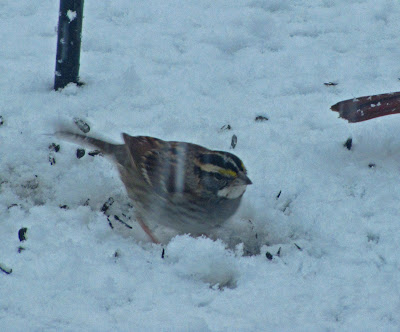Winter, while long and hard in these mountains, still holds an enchantment and amazing beauty. Everything is draped in white and the fresh snow adds a mystical beauty to the earth.
Most fascinating of all, are the many visitors that frequent our feeders. These include a number of different species of birds along with gray, red and fox squirrels. Last year we had beautiful fox squirrels, but, sadly, we have not seen them since this year's hunting season. We've only seen one squirrel, a small gray one. Sometimes, we are less than thrilled to see our feeders tossed about or the poles bent to the ground as the local bear stops by during the night.
We have a number of sassy Blue Jays that feed upon the suet cakes. These highly intelligent birds often gain a negative reputation at feeders because of their dominance over other species. They have been known to eat the eggs and nestlings of other birds; however, according to Cornell University, studies have shown the contents of jay's stomachs to contain as little as 1% of these. Their preferred diet is nuts and insects. When they are feeding peacefully or tending to nestlings, their crests lower. The oldest known wild, banded Blue Jay lived for over seventeen years.
Every year I make learning a new naturalist subject my priority. In 2009, I learned to recognize many of the regional butterflies. Last summer I decided to learn bird calls and to better identify the birds that I saw. I came to the realization that this will probably take a long time. For example, at first I thought the birds at the feeder in the picture above, were House Finches and therefore exotics. A more careful examination of another picture of the female identified her as a Purple Finch. As I zoomed in on the male, I thought that perhaps he has more pinkish color and fewer stripes than a House Finch and may be, after all, a Purple Finch.
This Slate-colored Junco or Snowbird is enjoying a seed.
The Chickadees are such delightful little birds but so hard to photograph. They tend to dart in to get a seed and then quickly take flight to another area to eat it.
The male Cardinal is undoubtedly one of the most well known of the birds that come to feeders. His stunning red color makes him stand out above all other birds.
Most female songbirds do not sing, but the female Cardinal does. Her song is generally longer and more complex than her mate's. Ornithologists believe that she sings while on the nest to communicate with the male.
These are American Goldfinches with their drab winter coat. The bird in the lower right corner of the photo is a male which can be distinguished from the female by the gold bar at the top of his wing above the black feathers. One of the earliest signs of the approach of spring and summer is the slow appearance of bright yellow feathers on them as end of winter approaches. My father always called them his "little dandelions". They also molt again, at the end of summer, to a much duller color for winter as displayed above.
We get a lot of woodpeckers on our suet feeders. Yesterday, my husband saw our phantom Pileated Woodpecker. We frequently hear but rarely see him. He's a handsome and noisy fellow about the size of a crow and with a big red crest. This little bird is probably a female Downy Woodpecker. The bird's body is so twisted, that with my amateur status, I can't tell for certain, but it seems too small for a Hairy Woodpecker.
This is a female Red-bellied Woodpecker. She has only a red nape whereas the male has red on his head and nape. It's a strange name for a bird whose red belly spot is difficult to see.
A Cardinal, Slate-colored Junco, and a female Purple Finch.
We frequently get Song Sparrows at our feeders. This past summer, we had three nests built in the garden areas near our home. I was excited to see this sparrow, a White-throated one at my feeder as well. Both species of birds do a comical little back strut as they dig in the snow for seeds. I learned something interesting from the Cornell Lab of Ornithology website called "All about Birds". The Dark-eyed Junco and the White-throated Sparrow will occasionally mate and produce hybrids. Their offspring look like grayish, dully marked White-throated Sparrows with white outer tail feathers.
There are a number of sites on the Internet that provide bird identification and information as well as audio of their songs. My favorite is the one by the Cornel Lab of Ornithology http://www.allaboutbirds.org/. It's a great way to learn about these wonderful little creature who so enrich our lives.














No comments:
Post a Comment